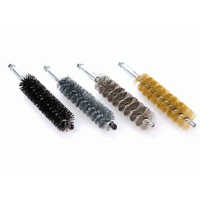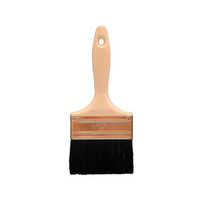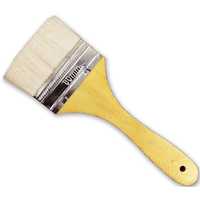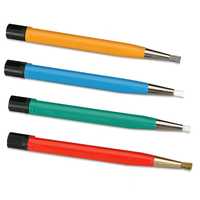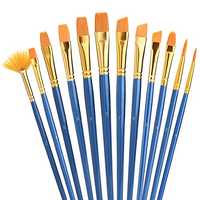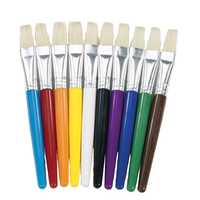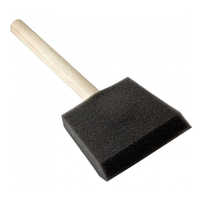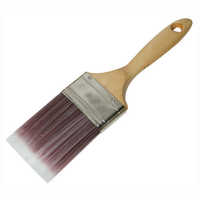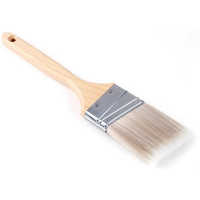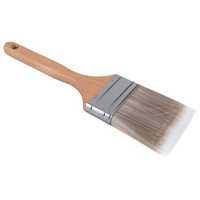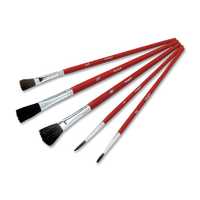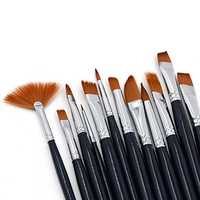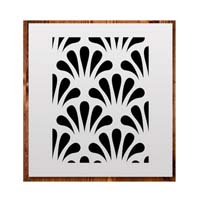Paint Brushes
(1565 products)
Explore More Categories
Made in India
Painting Brushes
Price Trend: 28.00 - 40.00 INR (Approx.)/Piece
MOQ - 50 Piece/Pieces
13 Years
Business Type: Manufacturer | Distributor
RADHE KRISHNA INDUSTRIES
Made in India
Paint Brushes
MOQ - 100 Piece/Pieces
16 Years
Business Type: Manufacturer | Exporter
VISHWKARMA IMPEX PVT. LTD.
Indian Inquiries Only
Made in India
Esd Brush Round Paint Type
1 Years
Business Type: Service Provider
PB STATCLEAN SOLUTIONS PVT. LTD.
Made in India
Texturing Brush, Usage/Application: CONCRETE ROAD PURPOSE
Business Type: Manufacturer | Service Provider
LOTUS TRADERS
Indian Inquiries Only
Brass Wire Nylon Kalam Painting Brush
Price: 130 INR (Approx.)/Set
MOQ - 100 Set/Sets
Usage - Painting
Product Type - Nylon Kalam Painting Brush
Brush Material - Brass Wire
3 Years
Business Type: Manufacturer | Distributor
A.R.TRADING COMPANY
Made in India
Nylon Willson Pvc Paint Brush
Price: 200 INR (Approx.)/Piece
MOQ - 100 Piece/Pieces
Size - 3 inch
Usage - Wall Painting
Color - Blue
2 Years
Business Type: Manufacturer | Trading Company
WILLSON ENTERPRISES
Light Weight Paint Brush
Price: 30 INR (Approx.)/Piece
MOQ - 100 Piece/Pieces
2 Years
Business Type: Distributor | Trading Company
ANKIT FIBER
Wood Flat Paint Brush Feature Durable
Price: 150 INR (Approx.)/Piece
MOQ - 100 Piece/Pieces
Business Type: Trading Company
SHUBHAM PAINTS & CHEMICAL
SARA Paint Brushes
3 Years
Business Type: Manufacturer | Exporter
SARA HOUSEHOLD PRODUCTS
Waterproof Paint Brush Size: Customized
Price Trend: 50-250 INR (Approx.)/Piece
MOQ - 01 Piece/Pieces
Product Type - Paint Brush
Usage - Industrial
Function - Dust Proof, Cleaning
4 Years
Business Type: Manufacturer | Trading Company
H.M.F. KHADDAR FACTORY
Paint Brush for Superior Finish with Precision
Price: 90 INR (Approx.)/Piece
MOQ - 350 Piece/Pieces
Product Type - Paint Brush
Handle Color - Blue
Size - Comes in various sizes
Business Type: Manufacturer | Distributor
Rihan Brush Corporation
Paint Brush - Color: Black
Price: 500 INR (Approx.)/Set
MOQ - 100 Set/Sets
Brush Shape - Oval-Shape
Usage - Paint Brushes
Color - Black
Business Type: Supplier | Trading Company
Jinay Automobile
Multicolor 6.3 Mm Thick 8 Inch Nylon Bristle And Wooden Handle Paint Brush
Price: 80 INR (Approx.)/Piece
MOQ - 2000 Piece/Pieces
Size - 8 Inch
Color - Multicolor
Length - 8 Inch (in)
Business Type: Trading Company
AVNI ENTERPRISES
Easy To Clean And Light Weight Paint Brush
Price: 25 INR (Approx.)/Pack
MOQ - 10 Pack/Packs
Color - alltype
Product Type - Paint Brush
Usage - Home and Office
Business Type: Distributor | Supplier
Scoffco
Synthetic Fiber Paint Brush
Price Trend: 150.00 - 150.00 SGD ($ (Approx.)/Box
MOQ - 100 Box/Boxes
Product Type - Paint brush
Weight - 150 Grams (g)
Color - White black
5 Years
Business Type: Manufacturer | Supplier
YADAV TRADERS
Ingco CHPTB0114091 9 Pcs Paint Brush Set for Oil Based Paint
Price: 325 INR (Approx.)/Piece
MOQ - 25 Piece/Pieces
Usage - Oil Based Painting Use
Product Type - Paint Brush Set
Function - Other
Business Type: Supplier | Exporter
Sourcing Industrial
Premium Quality And Durable Wall Paint Brush
Price: 85 INR (Approx.)/Piece
MOQ - 1500 Piece/Pieces
Product Type - Paint Brush
Color - black
Usage - Home, office
Business Type: Distributor
AFZ ENTERPRISES
Maroon Wall Paint Soft Brush
Function - Other
Handle Color - Maroon
Size - All Size Available
Business Type: Manufacturer
P.P. Organics Private Limited
Excellent Strength And Good Quality Paint Brush
Price: 50 INR (Approx.)/Piece
MOQ - 100 Piece/Pieces
Usage - Paint
Product Type - Paint Brush
Color - Red
Business Type: Trading Company
Home Decoration
Paint Brush
Business Type: Manufacturer
Jai Shiv Shankar Industries
Wood Flat Paint Brush Feature Durable Flawless Finish
Price: 250 INR (Approx.)/Piece
MOQ - 50 Piece/Pieces
Usage - painting
Color - Paint Brush
Brush Material - Nylon
Business Type: Trading Company
S.S. Enterprises
Wall Paint Brush
Business Type: Manufacturer
Azra Enterprises
Bristle Fiberglass Brushes For Removing Rust
Price Trend: 1050.00 - 2400.00 INR (Approx.)/Pack
MOQ - 3000 Pack/Packs
Weight - 0.32 Ounce (oz)
Size - 75 mm
Length - 119 mm Millimeter (mm)
Business Type: Manufacturer | Supplier
Noble Engineering
MANGLA Paint Brushes
Business Type: Trading Company
Mangla Traders
Indian Inquiries Only
Nylon Wool Paint Brush
Price: 200 INR (Approx.)/Piece
MOQ - 100 Piece/Pieces
Color - Multicolor
Usage - Industrial
Brush Material - Nylon
Business Type: Trading Company
Aaisha Trader
Multi Artistic Flat Painting Brush - Color: Light Yellow And Orange
Price: 500 INR (Approx.)/Pack
MOQ - 500 Pack/Packs
Color - Light Yellow and Orange
Product Type - Multi Artistic Flat Painting Brush
Usage - Multi Artistic Flat Painting Brush
Business Type: Supplier | Trading Company
A K Enterprises
Red & Blue 100% Pure Black Bristle Paint Brush
Price Trend: 150.00 - 350.00 INR (Approx.)/Piece
MOQ - 500 Piece/Pieces
Color - 100% Pure Black & White Bristle
Length - 3.5" 3.75" & 4.75" Inch (in)
Size - 2.5" 3" & 4"
Business Type: Manufacturer | Supplier
RKT OVERSEAS
Reusable and Durable Wall Stencil
Price: 30 INR (Approx.)/Unit
MOQ - 50 Unit/Units
Color - Colour on demand as per availability
Width - .05 Centimeter (cm)
Height - 24 Centimeter (cm)
Business Type: Trading Company
SANIA TIN WORKS
Paint Brushes Manufacturers | Suppliers in India
| Company Name | Location | Member Since |
|---|---|---|
| Vishwkarma Impex Pvt. Ltd. | New Delhi, India | 16 Years |
| Radhe Krishna Industries | Ahmedabad, India | 13 Years |
| Yadav Traders | Delhi, India | 5 Years |
| H.M.F. Khaddar Factory | Moradabad, India | 4 Years |
| A.R.Trading Company | Delhi, India | 3 Years |
| Sara Household Products | Chennai, India | 3 Years |
| Willson Enterprises | Ahmedabad, India | 2 Years |
| Ankit Fiber | Indore, India | 2 Years |
| Pb Statclean Solutions Pvt. Ltd. | Delhi, India | 1 Years |
The Ultimate Guide To Paint Brushes
Around 2.5 million years ago, in the Paleolithic epoch, people began using paintbrushes to apply color to surfaces.
Types of Paint Brushes
Picking the Right Paint Brush
How to Care for Your Brushes
FAQs: Paint Brushes
- Natural brushes
- Flat Brush
- Wash Brushes
- Foam brushes
- Synthetic Bristles
- Flagged brushes
- Round Brushes
- Filbert Brushes
Related Categories
Abrasives
Acoustic Products
Acrylic Sheets
Air Blowers
Air Compressors & Air Separation Plants
Air Cooler
Air Dryers
Air Receiver
Air Valves
Aluminum Castings
Anchors
Anti Vibration Mounts
Ball & Roller Bearings
Ball Valves
Ballast Making Machines
Bearing Parts & Components
Bearings
Bellows & Expansion Joints
Belt Pulleys
Boilers, Components & Spares
Bolts
Bright Bars
Bristles
Burners/Industrial Burners & Incinerators
Bushings & Bushing Parts
Butterfly Valves
CNC Machined Components
Cable Pulleys
Capital Goods
Carbon & Graphite Products
Castor Wheels
Centrifugal Pumps
Centrifuges
Ceramics
Chains & Chain Link Fence Fittings
Cleaning Equipment
Clips, Clamps
Coils
Combustion Equipment
Compression Springs
Compressors & Allied Equipment
Control Valves
Conveyor & Conveyor/Industrial Belts
Cooling Tower & Chilling Plants
Corrosion Protection Materials
Coupling
Cranes
Cryogenic Equipment
Cutting Tools, Broaches & Cutters
Departmental Shelving
Diaphragm Valves
Die Castings
Dies & Moulds
Dies,Jigs,Fixtures
Diesel Engine & Electric Locomotive Spares
Draught Fan
EOT Cranes
Electric Hoists
Electric Motors & Engines
Electroplating Chemicals & Equipment
Elevators, Lifts & Escalators
Energy Management System
Engine Valves
Engineering Goods & Equipment
Engineering Plastics
Engraving Equipment
Extruded Profiles
Fasteners
Fiberglass Products
Filter Cartridges & Media
Filter Cloth, Filter Industrial
Filters-Air, Gas, Liquid
Filtration & Sedimentation Units
Flat Metal Processing Equipment
Float Valves
Fork Lift Truck Parts
Fork Lift Trucks
Forklifts
Foundry Raw Material & Equipment
Furnace Manufacturers
Galvanized Fasteners
Gantry Cranes
Gaskets
Gate Valves
Gauges & Gauge Glasses
Gear Boxes, Reduction Gears & Gear Cutting
Girder Cranes
Glass & Glass Products
Glass Cutting Tools/Glass Cutters
Globe Valves
Goliath Cranes
Grating
Hand & Allied Tools
Hand Pump
Hardware & Tools
Heat Exchangers
Heating Elements
Hex Bolts
Hex Nuts
Hooks & Mounts
Hoses
Hot Air Oven
Humidification & Ventilation Equipment
Hydraulic Hoses & Flexible Metal
Hydraulic Press
Hydraulic Press Brakes
Hydraulic Products & Equipment
Hydraulic Valves
Induction Heating Equipment
Industrial Automation
Industrial Brakes
Industrial Brushes
Industrial Clothing
Industrial Clutches
Industrial Cylinders
Industrial Dryers
Industrial Evaporators
Industrial Knives
Industrial Nets
Industrial Ovens
Industrial Rollers
Industrial Supplies Stocks
Industrial Supplies-General
Industrial Tape
Industrial Tools
Industrial Valves
Industrial Vibrator
Inspection Equipment
Instrumentation
Internal Combustion Engine
Jib Cranes
Laboratory Furniture
Laboratory Glassware & Equipment
Laundry Equipment
Lined Valves
Machine Tools Accessories
Marking Systems
Material Handling Equipment
Measuring Tools & Equipment
Mechanical Seals
Metallised Capacitor Films
Mining Equipment
Mining, Exploration & Drilling Machinery
Model Making Materials
Motor Couplings
Moulded Components
Moulds
Needle Valves
Needles
Nuts
Oil Seals
Outdoor Cooling Systems
Overhead Cranes
PVC Hoses
PVC Products
Paint Brushes
Painting Equipments & Maintenance
Perforated Sheets
Plastic Processing Machinery Parts
Plastic Valves
Plastic Welding Equipment
Plate Valves
Plug Valves
Pneumatic Products & Tools
Pneumatic Valves
Polish & Polishing Material/Machinery
Power Press
Precision Brass Components
Pressed Components
Pressure Gauges
Pressure Vessels
Pulleys
Pulverizers
Pump Spares Parts
Pumps & Pumping Equipment
Radiators
Refrigeration & Equipment
Rope Pulleys
Rope,Twines & Webbings
Ropes
Rotary Valves
Rubber & Rubber Products
Rubber Gaskets
Rubber Roller
Rubber Seals
Rubber Transmission Belts
Screws
Seals
Sensors & Transducers
Shaft Couplings
Shafts & Shaft Collars
Sheet Metal Components & Parts
Solenoid Valves
Springs
Stainless Steel Bolts
Stainless Steel Fasteners
Stainless Steel Nuts
Stainless Steel Valves
Storage Systems
Storage Tanks
Submersible Pumps
Surface Finishing Equipment
Synthetic Industrial Diamonds
Testing & Measuring Equipment
Thermostatic Bimetals & Thermostats
Trolleys & Carts
Tungsten Carbide
Ultrasonic Equipment
V-Belts
Vacuum Equipment & System
Valves
Valves Fittings
Vibrating Screen
Washers
Water Coolers
Weighbridge
Welding & Soldering Supplies
Welding Electrodes
Welding Equipment
Winches
Wire Drawing Dies
Wire Rope Hoists
Wire Ropes
